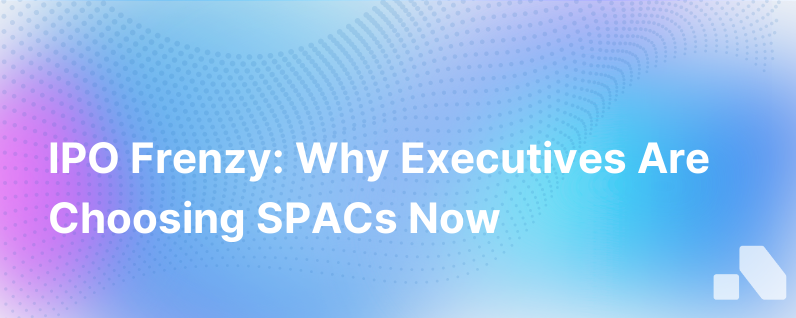Ipo Frenzy Spacs Are All The Rage
Published on January 2, 2024 by David Zhang
In the tumultuous seas of the financial markets, there is a new vessel that is catching the wind in its sails, swiftly becoming the maritime marvel of the investment world: the Special Purpose Acquisition Company—or SPAC, as it is commonly known. This vessel, not bound by traditional Initial Public Offering (IPO) constructs, offers companies a streamlined route to public trading and has sparked what can only be described as an IPO frenzy.
A SPAC, fundamentally, is a shell corporation designed for the sole intention of raising capital through an IPO to acquire an existing company. Hence the term "blank check company," implying the investors put their trust—and dollars—into the hands of SPAC sponsors, who will then target and merge with a private company looking to go public without undergoing the traditional IPO rigors.
The Rise of SPAC Popularity
The recent surge in SPAC popularity can be attributed to a confluence of factors. A frothy market flush with capital, coupled with a robust appetite for investment in innovative and disruptive companies, has provided the perfect environment for SPACs to flourish.
The notion that SPACs can significantly expedite the transition into a public entity is undoubtedly a primary allure. Traditional IPOs, with their lengthy and complex regulatory demands, significant due diligence, and fluctuating market conditions, can be a strenuous journey that many companies and their stakeholders would prefer to avoid.
SPAC Mechanics and Merits
Operating as publicly-traded shell companies, SPACs raise funds with a clear mandate—to pursue deals that will lead to an acquisition or merger with a company hungry to hit the public markets. SPACs typically have two years to complete an acquisition, or they must return the funds to investors, adding a layer of urgency to this high-stakes treasure hunt.
Investors are drawn to the SPAC model for several reasons:
- Participation in Business Combination Selection: Shareholders vote to approve or reject proposed acquisitions.
- Potential Upside of Investments: Investors often see SPACs as a ticket to early-stage investment in what could be the next heavy-hitter on the stock exchange.
- The Caliber of Sponsorship: Renowned investors or corporate leaders often spearhead SPACs, riding on their reputation and past successes, injecting confidence into their potentials.
Market Sentiments and Considerations
The SPAC boom has elicited a diverse range of sentiments within the financial community. Proponents hail the financial innovation, emphasizing how it democratizes public offerings and allows retail investors to get in on the ground floor of potentially lucrative deals that were once the exclusive purview of venture capital firms.
However, critics warn of the risks. SPACs are, after all, speculative by their nature. The value of a SPAC is directly tied to the success of the acquisition and the performance of the resultant merged entity. Detractors caution about inflated valuations and the allure of rapid returns potentially blinding investors to the nuanced and inherent risks.
The role of due diligence, or perhaps the lack thereof, is also at the center of the debate. There are concerns that the expedited process and the forward-looking financial projections allowed in SPAC transactions, unlike traditional IPOs, might lead to inadequate scrutiny, leaving investors susceptible to losses.
The Regulatory Outlook
Regulatory bodies are beginning to cast a more scrutinous gaze upon this burgeoning sector. As SPAC transactions multiply, so does the likelihood that the Securities and Exchange Commission (SEC) and other financial authorities will enhance oversight to protect investors and maintain market integrity.
This regulatory scrutiny could potentially temper the SPAC enthusiasm, as more stringent controls might erode the ease and speed advantages that SPACs currently offer. There's a delicate balance to be struck here—ensuring investor protection while not stifling the financial innovation that SPACs represent.
The SPAC Forecast
Whether SPACs are a meteoric financial structure or a sustainable investment paradigm, the fact remains—they are reshaping the IPO landscape. For now, their popularity endures, fueled by tales of monumental valuations and breakneck public launches.
The forecast suggests a high chance of continued SPAC deals, with perhaps incremental cooling periods as the market digests the rapid expansion of these entities, coupled with a heightened regulatory focus.
Reflections in the SPACscape
The SPAC frenzy has not emerged in a vacuum but as a natural progression of a market looking for efficient ways to increase liquidity and offer more companies the benefits of public capital. It is a powerful narrative featuring the thrill of financial innovation and the promise of democratization of investment opportunities.
As in all tales of money and markets, wisdom dictates a cautious approach—an acknowledgment of the risks illuminated by the bright lights of potential rewards. Investors are advised to navigate these waters with a deciphering eye, looking beyond the SPAC hype to understand the long-term prospects of the underlying business ventures.
A Look at the Horizon
As this IPO frenzy unfolds, startups, investors, and industry observers alike are keenly watching SPACs and their impact on capital markets. Regardless of their future, they currently stand as a testament to the ever-adaptive and innovative spirits of the financial markets, bringing both excitement and a note of caution to the high-octane world of public trading.
SPACs have come a long way since their inception, and whether they will stand the test of time or be categorized as a peculiarity of our times, yet remains to be seen. But for now, the SPACs are indeed all the rage—a phenomenon in the financial world that continues to draw in the hopeful, the curious, and the adventurous.